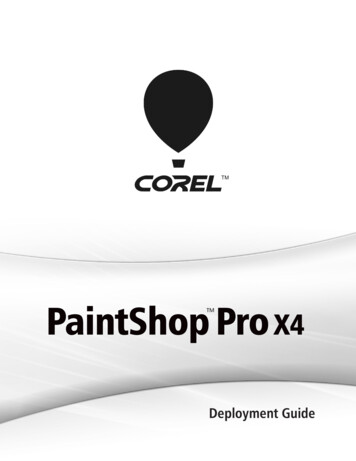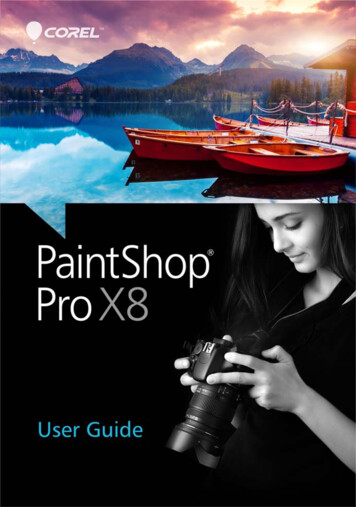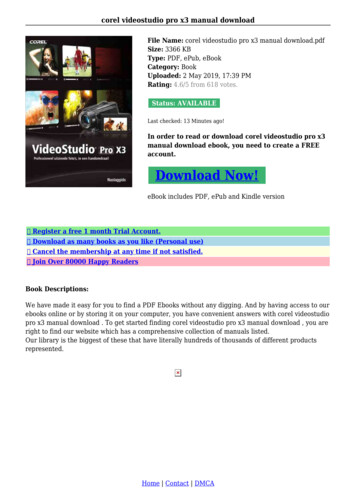
Transcription
IntroductionAs you read through this guide,you’ll find that the right columnof each page contains the maincontent, while the left columncontains the following categoriesof information:definition — explains theitalicized term or concepttip — presents a helpfuldetail, such as a shortcut,variation, or benefitnote — presents anadditional detail about thespecified topic or taskwarning — presents acrucial detail about thespecified topic or taskThe left column also gives youroom to jot down notes.This guide is intended to help you deploy Corel PaintShop Pro X9(Corporate and Education Edition) to your network as quickly andeasily as possible.ContentsStage 1: Preparing for deployment . . . . . . . . . . . . . . . . . . . . . . . 2Stage 2: Creating the server image . . . . . . . . . . . . . . . . . . . . . . . 3Stage 3: Installing the software . . . . . . . . . . . . . . . . . . . . . . . . . . 5Stage 4: Maintaining the installations . . . . . . . . . . . . . . . . . . . . 15Additional resourcesIf you are new to software deployment or otherwise require morebasic information on deploying Corel software products, pleaserefer to the Corel Beginner’s Guide to Network Deployment. Youcan request a copy of this guide from your Corel Support Servicesrepresentative.For even more information, see the following Web resources.Web resourceDescriptionCorel website:Information about Corel Corporationand its portfolio of software productswww.corel.comCorel Support Serviceswebsite:www.corel.com/supportCorel Knowledge Base :www.corel.com/kbInformation about product features,specifications, pricing, availability,services, and technical supportA searchable repository of articleswritten by the Corel Support ServicesteamFor help with the Microsoft Windows Installer (MSI) technologythat is used to install the software, please refer to the MicrosoftwebsiteDeployment GuideIntroduction1
Stage 1: Preparing for deploymentAs used in this guide, theterm “network” signifiestwo or more computersthat are connected to eachother for the purpose ofexchanging information.To deploy the software to your network as smoothly as possible,you can prepare by doing the following: Check the system requirements for the software. Prepare the server. Prepare the workstations.For details, see below.Checking the software requirementsWorkstations are thecomputers from whichthe average user works,and servers are the computersthat manage the sharedresources of the network.To begin, make sure that your server and workstations are eligiblefor the software. Consult the following: Readme file for the software (if available) product-information page on the Corel website (www.corel.com) any other special instructions for the softwarePreparing the server Make sure that the server meets the minimum systemrequirements for the software, and that it has enough free diskspace for the installation. Make sure that the operating system on the server has beenupdated with the latest service packs and security patches. Make sure that you have the proper permissions for creating asoftware image on the server. You must be either a localadministrator or an administrator for the domain that you aremanaging, and you must have read/write access to the serverlocation.Preparing the workstationsTo more easily managethe access rights ofworkstation users, youmay want to use Group PolicyObjects (GPOs, or “systempolicies”). See “Managingpermissions with Group PolicyObjects” on page 5. Make sure that the workstations meet the minimum systemrequirements for the software, and that they have enough freedisk space for the installation. Make sure that the operating systems on the workstations havebeen updated with the latest service packs and security patches. Make sure that anyone who will be installing the software fromthe server image has the proper permissions to do so. To installthe software on a workstation, you must be either a localadministrator or an administrator for the domain that you aremanaging, and you must have read access to the server location.Deployment GuideStage 1: Preparing for deployment2
Stage 2: Creating the server imageA server image, also calledan “administrator image”or simply an “image,” is aset of uncompressed applicationfiles on the server that is createdfrom a set of compressed files onthe installation disc.After preparing for deployment, you’re ready to create a serverimage of the software, from which you can install the software tothe workstations. (If you want to support multiple installationtypes, you can even create multiple server images: one for eachdesired configuration.)ContentsCreating a server image . . . . . . . . . . . . . . . . . . . . . . . . . . . . . . . . 3Finalizing the server image . . . . . . . . . . . . . . . . . . . . . . . . . . . . . 4Creating a server imageA command line is a textualcommand that lets youspecify desired settings.To create a server image, you run a command line that initializesthe software setup and specifies your desired installation settings.To run a command line1Open the Run dialog box (shortcut key: Windows Logo R).2Type the command line in the Open box, and then click OK.To create a server imageTo mount an ISO file,you might require thirdparty software thathelps you create a virtual drive.Alternatively, you can burn theISO file to a CD/DVD andaccess the files from the disc.1Do one of the following: If you have an installation disc, insert the disc into the CD/DVDdrive. If you downloaded an ISO file, mount the ISO to a directory orextract the files from the ISO image to a directory on yourserver by using a utility such as WinZip (available fromwww.winzip.com).If the AutoRun screen opens, click Exit.2Run the following command line, where X: is the directorywhere the disc, ISO, or extracted files are located.X:\Setup.exe /a3Type your user name and serial number (with or withouthyphens) in the boxes provided, and then click Next.The customer information that you provide is passed on to theworkstations when the software is deployed to the network. Bydefault, users can change the user name but not the serialnumber.4Specify a network location for the server image. To change thedefault location, type a valid server path in the Network locationbox, or click Browse to browse to a valid network location.Deployment GuideStage 2: Creating the server image3
5If you want to allow workstations to detect and downloadproduct updates, enable the Product updates check box.6Click Install to begin copying the files to the server.If you click Cancel, you are prompted to confirm that you wantto cancel creating the server image. Cancelling “rolls back” thesetup and undoes most of the changes made; however, somemanual clean-up may be required.7Click Finish.You can alsoCreate a serverimage silently(or with limitedUI)Use the following command line (where X: is thedirectory where the disc, ISO, or extracted files arelocated; image location is the desired location ofthe server image; and serial number is the assignedserial number for the product):X:\Setup.exeTARGETDIR "image location"SERIALNUMBER "serial number"Proceed with extremecaution when using the/q switch to create aserver image./q /aThe /q switch is used to restrict the amount of theuser interface that appears during installation. For alist of switch parameters, see page 7.Create an errorlogUse the following command line (where log fileis the location and filename of the log file):X:\Setup.exe /l "log file" /aFor a list of the parameters that are available forthe /l switch, see page 8.Finalizing the server imageTo change the location ofa server image, you mustcreate a new image at thenew location. You cannot copyan image from one location toanother.Before deploying from the server image, you may want to take thefollowing steps.Check for software updatesCheck for software updates, and apply them to the image asnecessary. This way, you can avoid having to deploy the softwaretwice. For details, see page 16.Test the imageTest the image with a small subset of workstations before rolling itout to your entire organization.Deployment GuideStage 2: Creating the server image4
Stage 3: Installing the softwareLooking for commandline switches and publicproperties? See “Pushingthe software” on page 6.You can install the software on the workstations in two main ways: by having the users themselves install (or “pull”) the softwarefrom the server image to their workstations by using a command line to install (or “push”) the software fromthe server image to the workstations on the users’ behalfContentsPulling the software . . . . . . . . . . . . . . . . . . . . . . . . . . . . . . . . . . 5Pushing the software. . . . . . . . . . . . . . . . . . . . . . . . . . . . . . . . . . 6Pulling the softwarePulling the softwareinvolves having theworkstation usersthemselves execute thesoftware installation andperhaps even choose their owninstallation options.Workstation users themselves can install (or “pull”) the software byusing one of the following methods: browsing to the location of the server image, double-clickingSetup.exe, and following the instructions in the setup. This is themost common method for pulling the software. running a command line that installs the software from thesetup on the server image. Typically, this method is reserved forpush-installation scenarios (see page 6).Managing permissions with Group Policy ObjectsGroup Policy Objects(sometimes called“system policies”) residein a central location on aWindows-based network anddefine how each workstation isconfigured.To install the software, workstation users require administratorlevel privileges. To assign such privileges, Windows-based networksuse Group Policy Objects (or “GPOs”): items stored in a centralnetwork location and used to automatically update the registrysettings on each workstation when its user logs in to the network.If you want to give users administrator-level access rights (eithertemporarily or permanently), you may need to configure the GPOsfor your network by using a Group Policy Editor.For general help with GPOs, please refer to the SoftwareDevelopment Kit (SDK) for Group Policy.To access the Group Policy Editor for Windows1Open the Run dialog box (shortcut key: Windows Logo R).2Type gpedit.msc in the Open box, and then click OK.Deployment GuideStage 3: Installing the software5
To let workstation users install softwareEnable the following system policies for workstation users: Computer Configuration\Administrative Templates\Windows Components\Windows Installer\Always install with elevated privileges Computer Configuration\Administrative Templates\Windows Components\Windows Installer\Enable user control over installs User Configuration\Administrative Templates\Windows Components\Windows Installer\Always install with elevated privilegesTo let limited-access users patch softwareEnable the following system policy for workstation users: Computer Configuration\Administrative Templates\Windows Components\Windows Installer\Enable user to patch elevated productsPushing the softwarePushing the softwareforces installation on theworkstations withoutrequiring any user interaction.Typically, the user interface forthe setup is suppressed.If you prefer to install the software on behalf of the workstationusers, you can “push” the software from the server image to theworkstations. To do this, you use a command line in conjunctionwith one of the following: a batch file — a text file that can be scripted to run commandsautomatically. For help, please visit the Microsoft website. a Group Policy Object — an item, stored in a central networklocation, that defines how the workstations are configured. Forhelp, please refer to your Software Development Kit (SDK) forGroup Policy. a push technology — a third-party tool specially designed forinstalling software automatically. For help, please visit themanufacturer’s website.Command-line switchestypically control thebehavior of the softwaresetup, while public propertiestypically pre-configure theinstalled software.As previously stated, all three of these methods involve softwareinstallation command lines, which typically include the following: the setup file on the server image switches that control the setup behavior public properties that pre-configure the installed softwareAbout command linesSpecifying the setup file. . . . . . . . . . . . . . . . . . . . . . . . . . . . . . . . 7Using switches . . . . . . . . . . . . . . . . . . . . . . . . . . . . . . . . . . . . . . 7Using public properties . . . . . . . . . . . . . . . . . . . . . . . . . . . . . . . 10Deployment GuideStage 3: Installing the software6
Specifying the setup fileThe main item to specify in your command line is the executablefile that you want to use to install the software.This file is Setup.exe, the executable file for the software setup.Setup.exe is located on the server image, at the installation paththat you chose when you created the server image.The basic syntax for a Setup.exe command line is as follows:\\server\path\Setup.exeIf your server-image path contains spaces, you must placequotation marks around the entire Setup.exe component:"\\server\path with spaces\Setup.exe"Using switchesTo customize the behavior of the software setup, you can use avariety of command-line switches.Basic syntaxSeparate switches fromother command-lineelements, including otherswitches, with spaces.The syntax for a switch consists of a forward slash ( / ) immediatelyfollowed by a character or string — for example, /q or /quiet.Be sure to separate switches from other command-line elements,including other switches, with spaces.ParametersDo not type a spacebetween a switch and itsparameters or betweenthe parameters in one switch,unless otherwise noted.For a list of all switches forthe Microsoft WindowsInstaller technology, pleasesee the Microsoft website.After installation with the/q switch, it is normal forthe licensing agreement toappear the first time that usersrun the program on theirworkstations.Some switches have parameters, which let you adjust the settingsfor the switch. In fact, some switches let you use multipleparameters.To use a parameter, simply type the parameter immediately afterthe switch (that is, without a space), unless otherwise noted. If youdo not specify any parameters, the switch uses its default settings.Available switches, by functionLimiting the setup UI with /q . . . . . . . . . . . . . . . . . . . . . . . . . . . . 7Creating a log file with /l . . . . . . . . . . . . . . . . . . . . . . . . . . . . . . . 8Controlling reboots . . . . . . . . . . . . . . . . . . . . . . . . . . . . . . . . . . . 9Limiting the setup UI with /qThe /q switch can be used to restrict the amount of the userinterface (UI) that appears during installation. You can use theswitch to prevent users from entering their own registrationDeployment GuideStage 3: Installing the software7
information, to help enforce specific installation options, or even toperform “silent installations” (in which no user interface is visibleduring the setup).The default parameter for/q is n.The /quiet switch canbe used in place of /qn.ParametersYou can specify one of the following parameters for the /q switch.ParameterEffectnThe user does not see the user interface during installation.Errors are recorded in a log file (see page 8). This is thedefault parameter.bThe user sees only a progress bar and a Cancel button. Ifthe user pushes the Cancel button, the installation is rolledback.rThe user sees a progress bar, along with a page containinginformation about the installation. The user can choose tocancel the installation.fThe user sees the full user interface.The /passive switch canbe used in place of /qb.SyntaxHere’s the command-line syntax:\\server\path\Setup.exe /qCreating a log file with /lUse the /l switch if you want to log general information about theinstallation to a log file with the specified path and filename.ParametersThe default parameters forthe /l switch areiwearmo.You can specify one or more of the following parameters for the /lswitch.ParameterEffectiLogs status messageswLogs nonfatal warningseLogs all error messagesaLogs initiated actionsrLogs action-specific recordsuLogs user requestscLogs initial user-interface parametersDeployment GuideStage 3: Installing the software8
The /log switch can beused in place of /l*.ParameterEffectmLogs error messages about out-of-memory warnings orfatal exitsoLogs error messages resulting from insufficient hard diskspace during installation to a serverpLogs terminal propertiesvLogs very detailed information*Applies all parameters except v, recording all informationin a single log fileLocation and filename of log fileThe /l switch can take an additional parameter: the location andfilename of the log file. Type /l followed by a space, followed byan opening quotation mark, the path to the log file, the filenameof the log file, and a closing quotation mark. Here’s the commandline syntax (where log file is the location and filename of the logfile):\\server\path\Setup.exe /l "log file"SyntaxThe following sample command line uses the default parameters ofthe/l switch to log information in the file C:\install.txt duringinstallation:\\server\path\Setup.exe /l "C:\install.txt"Using the /q switch with /lYou can use the /q and /l switches together. The following samplecommand line uses /q to suppress the user interface duringinstallation and record errors in the specified log file:\\server\path\Setup.exe /q /l "C:\Logs\My Log.txt"Controlling rebootsYou can force a reboot after installation by using the /forcerestart switch in your command line. Here’s the commandline syntax:\\server\path\Setup.exe /forcerestartDeployment GuideStage 3: Installing the software9
You can also suppress a reboot after installation by using the/norestart switch. Here’s the command-line syntax:\\server\path\Setup.exe /norestartAdditional informationon the use of publicproperties is availableonline from the MSDNdeveloper program.Using public propertiesTo customize the installed software, you can use a variety of publicproperties in your command line.Basic syntaxPublic properties are case-sensitive; they must be typed in capitalletters, and they cannot contain spaces.Be sure to use spaces toseparate publicproperties from othercommand-line elements(including other publicproperties).Use quotation marksaround any value thatcontains spaces toensure it is “read” as a singleunit.For a list of all publicproperties for theMicrosoft WindowsInstaller technology, please seethe Microsoft website.To use a public property in a command line, you must type thename of the public property in capital letters, followed directly byan equals sign ( ), followed directly by the desired value.PROPERTY valueValues are also case-sensitive, but they can contain both uppercaseand lowercase letters. A value can be a text string (such as a featurename) or a number. If a value contains spaces, you must enclose itin quotation marks to ensure that it is “read” as a single unit.PROPERTY "value containing spaces"Available public properties, by functionInstalling the software at a specified location. . . . . . . . . . . . . . . 10Installing the specified application module. . . . . . . . . . . . . . . . . 11Installing language modules for the software. . . . . . . . . . . . . . . 11Controlling network-related features of the software . . . . . . . . . 12Controlling license-agreement prompts for the software . . . . . . 12Controlling the installation of desktop shortcuts . . . . . . . . . . . . 12Controlling file associations for the software . . . . . . . . . . . . . . . 12Specifying the locations of user resources . . . . . . . . . . . . . . . . . 13Controlling the database import process . . . . . . . . . . . . . . . . . . 13Controlling when user data is created . . . . . . . . . . . . . . . . . . . . 14Installing the software at a specified locationFor best results, encloselocation in quotationmarks.You can use the INSTALLDIR public property to install the softwareat a specific location on the workstations. The value for thisproperty is the desired installation location. Here’s the commandline syntax:\\server\path\Setup.exe INSTALLDIR "location"Deployment GuideStage 3: Installing the software10
Installing the specified application moduleDo not set the propertiesof both INSTALLX86 andINSTALLX64 to 0.Otherwise, neither version willbe installed.Both 32-bit and 64-bit application modules of Corel PaintShop ProX9 are installed on a 64-bit OS by default. You can use theINSTALLX86 and INSTALLX64 public properties to specify yourpreferred application module.Here’s the syntax for installing the 32-bit version only:\\server\path\Setup.exe INSTALLX86 1 INSTALLX64 0Here’s the syntax for installing the 64-bit version only:\\server\path\Setup.exe INSTALLX86 0 INSTALLX64 1Installing language modules for the softwareYou can use the INSTLANG public property to install languagemodules for the software. A language module typically includesboth the user-interface and the offline Help for that language.English (EN) is alwaysinstalled, so it does notneed to be specified.When installing multiplelanguages, do not leavespaces between thecomma and the languagecodes.The accepted value for this property is the two-letter code for anyof the following supported languages: Chinese Traditional: CT Dutch: NL English: EN French: FR German: DE Italian: IT Japanese: JP Spanish: ES Russian: RUHere’s the command-line syntax:\\server\path\Setup.exe INSTLANG codeInstalling more than one language moduleYou can install multiple languages by using comma separators, asin the following example:\\server\path\Setup.exe INSTLANG EN,FR,DEIf FORCELANG specifies alanguage module notalso specified byINSTLANG, the softwaredefaults to English.When installing multiple language modules, you can use theFORCELANG public property to specify the default module. As withINSTLANG, the accepted value for this property is a two-letterlanguage code.Deployment GuideStage 3: Installing the software11
In the following example, the English, French, and Germanlanguage modules are installed, but French is specified as thedefault:\\server\path\Setup.exe INSTLANG EN,FR,DE FORCELANG FRControlling network-related features of the softwareDisabling networkrelated features withIOFF 1 also disables inproduct messaging, along withautomatic updates.You can disable ALL network-related features of the installedsoftware by specifying a value of 1 for the IOFF public property.Here’s the command-line syntax:\\server\path\Setup.exe IOFF 1Controlling license-agreement prompts for the softwareIf the software is installed silently, the workstation user will beprompted to accept the End-User License Agreement (EULA) at firststart-up. You can suppress the EULA prompt on the workstationsby specifying a value of 1 for the FORCENOSHOWLIC public property.Here’s the command-line syntax:\\server\path\Setup.exe FORCENOSHOWLIC 1IMPORTANT: Please note that if you choose to suppress the EULAprompt on the workstations, you are accepting the terms of theEULA on behalf of all users on your network when you create theserver image.Controlling the installation of desktop shortcutsBy default, every workstation receives desktop shortcuts for thesoftware. You can disable the installation of these shortcuts byspecifying a value of NONE for the DESKTOP public property. Here’sthe command-line syntax:\\server\path\Setup.exe DESKTOP NONEControlling file associations for the softwareDepending on the version of the OS, some file formats areautomatically associated with Corel PaintShop Pro X9. You candisable these file associations by specifying a value of 0 for theCDS ASS IMAGE public property. Here’s the command-line syntax:\\server\path\Setup.exe CDS ASS IMAGE 0Deployment GuideStage 3: Installing the software12
Specifying the locations of user resourcesCorel PaintShop Pro X9 supports a variety of user resources — files(such as workspaces or images) that can be shared amongworkstation users over the network, or stored locally for personaluse. When deploying to the workstations, you can specify thelocations of the shared and local resource folders.Shared resource folderFor best results, encloselocation in quotationmarks.If you want to provide workstation users with a shared repositoryof resources, use the C GLOBALREAD public property. The value forthis property is the desired location of the shared network folder;all workstation users can access, but not modify, this folder.\\server\path\Setup.exe C GLOBALREAD "location"Local resource folderWhen a workstation user starts Corel PaintShop Pro X9 for the firsttime, a local resource folder (Corel PaintShop Pro\19.0) is created inthat user’s Documents (on Windows 10, Windows 8, andWindows 7) folder. The workstation user requires full (read/write)access to this folder — and is prompted to provide an emergencyfolder when it is unavailable.For best results, encloselocation in quotationmarks.If you want to customize the location of the resource folder on theworkstations, you can use the MY PSP FILES public property. Thevalue for this property is the desired location to the local folder;the resources stored in this user folder can be accessed only by thatuser. Here’s the command-line syntax:\\server\path\Setup.exe MY PSP FILES "location"Creating user resourcesFor details on creating user resources for Corel PaintShop Pro X9,please see the Help.Controlling the database import processBy default, when you install a new version of Corel PaintShop ProX9, it imports the database from the previous version. If you wantto start with a clean database, you can turn off the importingaction by using the following command:IGNORE.IMPORTDB 1Here’s the command-line syntax:\\server\path\Setup.exe IGNORE.IMPORTDB 1Deployment GuideStage 3: Installing the software13
Controlling when user data is createdBy default, after you install the application, it launches andinitializes the user data setup. The following command lets yousuppress the initialization so that it occurs when the users firstlaunch the application:SKIPSILENTINIT 1Here’s the command-line syntax:\\server\path\Setup.exe SKIPSILENTINIT 1The initialization must occur, it’s just a matter of timing. In theevent that you have many seats and might not have sufficient timeto deploy the application, you can use this command option.Deployment GuideStage 3: Installing the software14
Stage 4: Maintaining the installationsYou can maintain the installed software in the following ways: Modify — to change which program features and languages areinstalled Repair — to resolve technical issues Remove (or “uninstall”) — to prepare to upgrade to the newestversion of the softwareYou can maintain a single installation of the software by using theWindows Control Panel, or you can maintain multiple installationsof the software by using command lines.ContentsMaintaining a single installation . . . . . . . . . . . . . . . . . . . . . . . . 15Maintaining multiple installations . . . . . . . . . . . . . . . . . . . . . . . 15Maintaining a single installationYou can use the Windows Control Panel to remove a singleinstallation of the software.To remove a single installation of the software1Log on to the workstation.2Open the Control Panel.3On Windows 10, Windows 8, Windows 7, click Programs, andclick the Uninstall a program link.4Choose Corel PaintShop Pro X9 from the list.5Click Uninstall/Change.Maintaining multiple installationsYou can use a command line to repair, update, or remove thesoftware.By using a push-installation method to deploy your command line(see page 6), you can maintain multiple installations of thesoftware.Command-line functionsRepairing the software . . . . . . . . . . . . . . . . . . . . . . . . . . . . . . . 16Updating the software . . . . . . . . . . . . . . . . . . . . . . . . . . . . . . . 16Removing the software . . . . . . . . . . . . . . . . . . . . . . . . . . . . . . . 17Deployment GuideStage 4: Maintaining the installations15
Repairing the softwareYou can use the command-line switch /reinstall to repair thesoftware by reinstalling it from the specified server image.Here’s the command-line syntax:\\server\path\Setup.exe /reinstallTo silently repair the software, include the /qn switch:\\server\path\Setup.exe /qn /reinstallUpdating the softwareHelp updates for locallystored Help files (alllanguages) are alsoavailable from the Corel supportwebsite. Follow the “Updatingthe software” instructions toupdate the server image anddeploy the Help toworkstations.Corel periodically releases Microsoft patch (MSP) files, or“patches”, for its products. Installing patches helps to keep thesoftware up-to-date.By default, the software is configured to use an automatic-updatefeature to detect when patches are available.However, you yourself must deploy updates to the workstations ifyou choose to disable to automatic-update feature (see“Controlling network-related features of the software” on page 12and “To create a server image” on page 3). In this scenario, youmust monitor the website for Corel Support Services(www.corel.com/support); when a patch is made available, you canthen download it to the server.Patching the server imageApplying a patch mayrequire you to re-enteryour customer informationand serial number. Just in case,keep these details handy.To apply a patch to the server image, use the following commandline syntax (where Patch.exe is the filename of the patch):Patch.exe /aIf desired, you can include the location of the server image:Patch.exe /a "\\server\path"Patching the workstationsTo deploy the update from the patched server image to theworkstations, use the following command-line syntax:\\server\path\Setup.exe /reinstallTo silently deploy from the patched server image, include the /qnswitch:\\server\path\Setup.exe /qn /reinstall
This guide is intended to help you deploy Corel PaintShop Pro X9 (Corporate and Education Edition) to your network as quickly and easily as possible. . product-information page on the Corel website (www.corel.com) any other special instructions for the software Preparing the server








